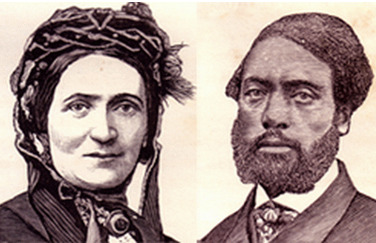#FugitiveSlaveAct
Explore tagged Tumblr posts
Photo

Where the Underground Railroad came to an end. Salem Chapel in what was St. Catharine’s “Coloured Town” is also the city‘s first national historic site. Most famous for being Harriet Tubman’s parish for the decade she lived in Canada as a free woman. Her home was directly across the street. • • • #stcatharines #stcatharinesontario #niagararegion #colouredtown #harriettubman #undergroundrailroad #salemchapel #blacklivesmatter #africanmethodistepiscopalchurch #AMEC #methodist #FugitiveSlaveAct (at British Methodist Episcopal Church, Salem Chapel) https://www.instagram.com/p/CDX59XUA-Ou/?igshid=1n0gi6zrnvl5d
#stcatharines#stcatharinesontario#niagararegion#colouredtown#harriettubman#undergroundrailroad#salemchapel#blacklivesmatter#africanmethodistepiscopalchurch#amec#methodist#fugitiveslaveact
0 notes
Text
Ellen and William Craft: The Careful and Courageous Path to Freedom
The steamship captain was enjoying his breakfast and his company. They were headed for Charleston, South Carolina and although the young gentlemen joining him that morning was obviously very ill, he and his slave, William, were good listeners. He commended the gentleman on how attentive his slave was, he was an excellent servant. But, he needed to be careful once they arrived north, almost certainly some “cut-throat” abolitionist would try to kidnap William and bring him to freedom. The captain rattled on…he had no idea who he was talking to.
*************************************************************************
Read the rest of the story in Hushed Up History Volume I, available now through Barnes and Noble and Amazon.com!

A later illustration of Ellen and William Craft.
#husheduphistory#featuredarticles#history#CivilWar#CivilWarHistory#GeorgiaHistory#PhiladelphiaHistory#BostonHistory#EllenCraft#WilliamCraft#escapingslavery#escapedslaves#FugitiveSlaveAct#mastersofdisguise#hiddeninplainsight#geniusplan#brilliant#historyofslavesinamerica#forgottenhistory#amazinghistory#slaveryinamerica#uglysideofhistory#greatescape#amazingstory#truestory#freedom#knowtheirnames#knowtheirstory#africanamericanhistory#bravery
0 notes
Photo

Harriet Tubman was here!! Stopped by Dorchester County on way back to D.C. To visit Tubman's birthplace, history trail & new museum!! #harriettubman #blackmoses #undergroundrailroad #fugitiveslaveact #md #localhistory #maryland #dorchester #bucktown #followthedrinkinggourd #thenorthstar #abolition #americanhero (at Harriet Tubman Underground Railroad National Historical Park)
#undergroundrailroad#md#americanhero#maryland#harriettubman#localhistory#bucktown#thenorthstar#followthedrinkinggourd#dorchester#blackmoses#abolition#fugitiveslaveact
2 notes
·
View notes
Photo

Who are You Remembering Today? Today, March 10th, We Celebrate the life of a truly fearless woman: #harriettubman #undergroundrailroad #runawayslave #fugitiveslaveact #warbetweenthestates #abolitionist #humanitarian #spy #scout #americanhistory #americanmoney #womensmonth
#americanmoney#scout#undergroundrailroad#womensmonth#harriettubman#fugitiveslaveact#warbetweenthestates#americanhistory#spy#humanitarian#abolitionist#runawayslave
0 notes
Photo

#Repost @pdjeliclark (@get_repost) ・・・ On September 18, 1850, Congress passed the Fugitive Slave Act. Broadsides like these went up in cities like Boston, warning the local Black community of slave-hunters by identifying and naming them. | Image courtesy of Boston Public Library #fugitiveslaveact http://ift.tt/2zHDq8X Follow #ADPhD on IG: @afrxdiasporaphd
8 notes
·
View notes
Link
Subscribe For Daily Updates. TODAYINCTHISTORY.com
#antislacery #civilwar #ctauthors #authorss #fugitiveslaveact #harrietbeecherstowe #litchfield #literature #lymanbeecher #abrhalincoln #slavery #slaveyrandabolition #uncletomscabin
0 notes
Photo

Following the news yesterday of Ernest Gaines’ death, we find ourselves observing the death of another iconic figure of African American literature, William Wells Brown on November 6, 1884. 📚 Best known for his novel “Clotel; or, The President's Daughter: A Narrative of Slave Life in the United States”, about the fictional slave daughters of Thomas Jefferson, Brown holds the distinction of being the first published African American author. 📚 He had escaped slavery in 1834 and was hiding out in London at the time of the book’s publication to evade possible recapture under the Fugitive Slave Act. 📚 #gsbauthorquotes #gsbquoteswilliamwellsbrown . . . . . . . . . . #gasstationburrito #onthisday #literaryhistory #bookstagram #books #bookworm #author #authorquotes #authormemes #writer #writerquotes #november6 #williamwellsbrown #slavery #clotel #thomasjefferson #sallyhemmings #africanamericans #africanamericanhistory #africanamericanliterature #americanliterature #slavenarratives #fugitiveslaveact https://www.instagram.com/p/B4iK48KgD3x/?igshid=1twg5o2hohbhz
#gsbauthorquotes#gsbquoteswilliamwellsbrown#gasstationburrito#onthisday#literaryhistory#bookstagram#books#bookworm#author#authorquotes#authormemes#writer#writerquotes#november6#williamwellsbrown#slavery#clotel#thomasjefferson#sallyhemmings#africanamericans#africanamericanhistory#africanamericanliterature#americanliterature#slavenarratives#fugitiveslaveact
0 notes